Everything you need to know about growing cannas
Cannas are one of the most tropical-looking plants. They tap into today’s trend towards exotic gardens.
But they can be grown in quite temperate climates.
I asked Stephen Ryan, Australian gardening broadcaster and owner of the Dicksonia Rare Plants nursery, for his advice on choosing and growing canna lilies. Stephen also has a YouTube channel, called The Horti-culturalists, where he talks about plants.
How to choose cannas
‘Although you may be choosing them for their flowers, they’re a wonderful foliage plant,’ says Stephen. ‘So think about whether you want red, green or grey based foliage.’
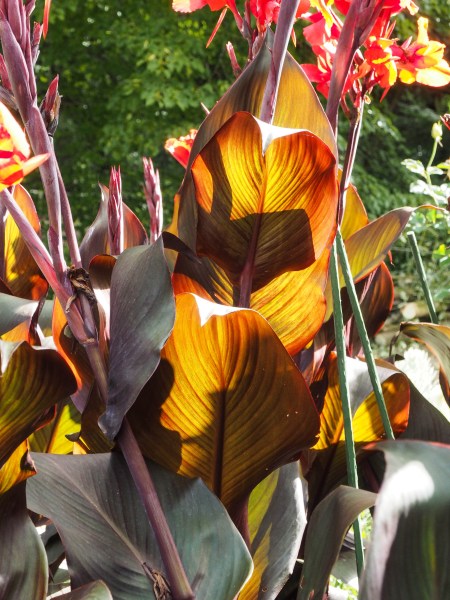
Sunlight on the red and green striped foliage of Canna Tropicana Black.
He also says that cannas come in a range of heights. ‘Some dwarf plants are less than a metre high, while the very tall ones can be up to three metres.’
In his opinion, the taller cannas look better in a border. ‘To my mind, there’s not much point in the smaller ones.’
Tubers or fully grown plants?
If you buy your canna lilies as tubers or rhizomes, Stephen advises you to look for a decent-sized plump rhizome, with several ‘eyes’. ‘A small piece may struggle to re-establish.’
If you live in a cool climate, plant the rhizomes up in pots any time from early spring onwards and keep them in a sheltered spot.
However, buying cannas as fully grown plants is a good option, ‘because then you know exactly what you’re getting.’
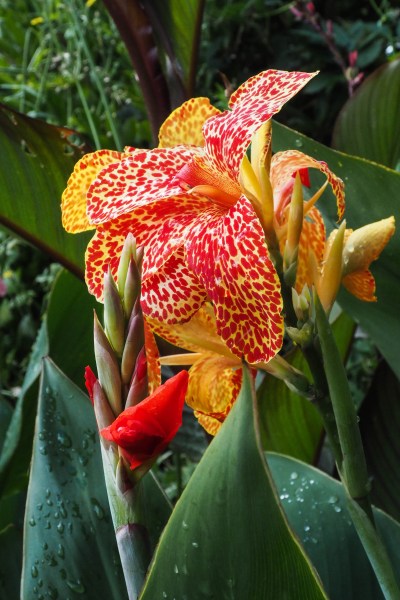
A heritage canna called ‘Zebra’, fully grown and ready to pop into a border, at Dicksonia Rare Plants.
‘Look for healthy looking leaves and a canna with several good stems growing from the base,’ he says.
Canna virus is a problem all over North America, the UK and Europe, so it’s a good idea to check the leaves. They should look healthy, not mottled or withered.
When to plant cannas
Stephen says you can plant the rhizomes in pots from early spring, but keep them somewhere sheltered and away from frosts. Plant them when the risk of frost is over.
He used to stay at Great Dixter when Christopher Lloyd was still alive:
‘Christo used to plant cannas in polystyrene boxes, then he’d grow them on until the mid-summer flowers in the borders were over. He’d remove plants from the Long Border once they were past their best and pop the cannas – ready to flower – into the gaps.’
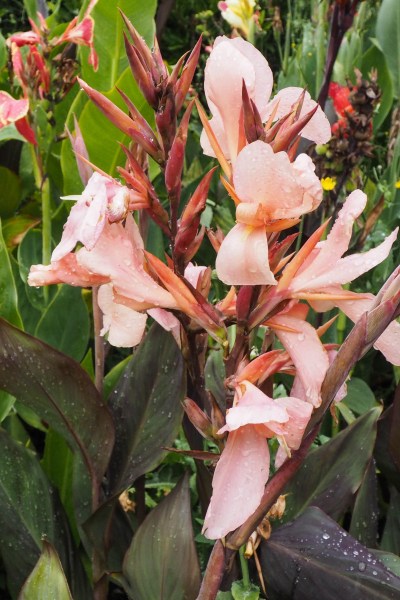
Not all cannas are vibrant in colour – this pretty pink is ‘Constitution’, a canna from the US.
This makes them a good plant for extending the interest of your border later into the summer.
They’re also very popular with pollinators, so are good if you want to encourage wildlife in your garden.
Cannas in pots
Canna lilies do well in pots. Choose larger pots for the larger cannas and remember that they are tall plants so they may be knocked over in the wind. The pots below show cannas at Kew Gardens. The taller cannas in pots are surrounded by smaller pots which will stop them being blown over.
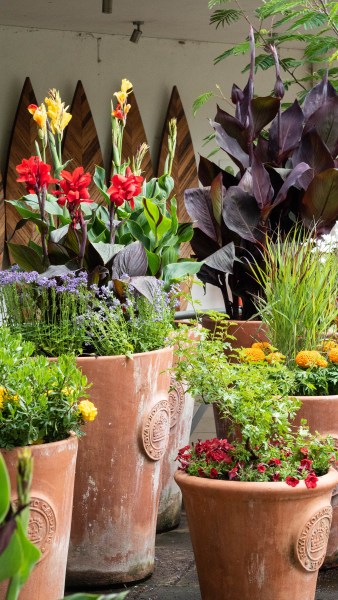
This display at Kew Gardens shows several cannas planted in each pot. This will need regular feeding and watering as cannas are hungry plants, but it looks wonderful.
Can cannas survive winter?
‘Cannas are tropical plants,’ says Stephen. ‘So they’ll have to be dug up and over-wintered in harsh climates.’
However they can survive mild temperate winters. Stephen lives near Melbourne in Australia where winter temperatures can drop below freezing. He doesn’t dig up his cannas, and just covers them with a layer of mulch, straw or bracken.
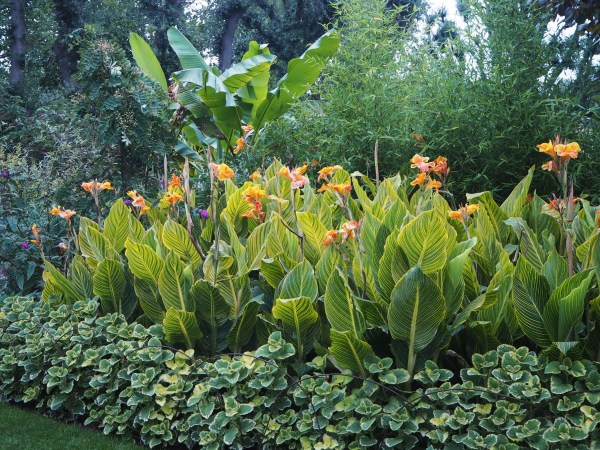
Canna ‘Bethany’ at The Salutation garden in Kent
And in the Salutation garden in Kent (UK), head gardener Steven Edney also leaves his cannas in the ground. ‘Once the foliage has collapsed after a frost, we fold it over the crown to help protect it, then we cover it with mulch,’ he says when talking about plants for late season colour.
Where to plant canna lilies?
They need an open, sunny spot in the border, according to Stephen Ryan.
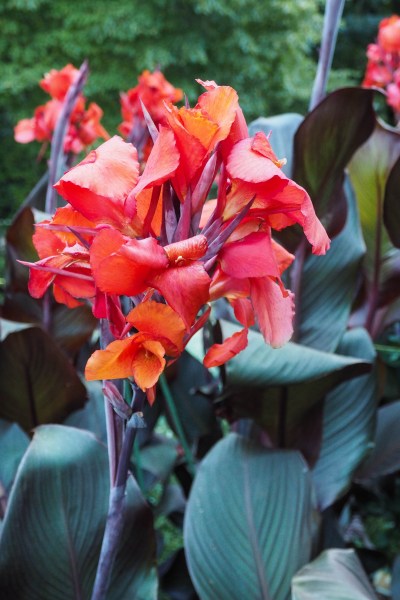
Canna Tropicana Black in an open, sunny spot.
Cannas are also very hungry and thirsty plants. ‘I advise people who plant cannas to plant them under a dripping tap and then tie a horse to the tap,’ says Stephen. ‘You can’t over-water or over-feed a canna.’
So add plenty of mulch when planting and top it up over the season.
How to prune cannas
Stephen recommends tidying up your canna flowers once they begin to fade. Some cannas drop their flowers before they go brown, but if not, simply pick the dying petals out.
Once the whole bloom has died, feel down the stem for the next flower coming up. It will feel like a bud on the side of the stem. Cut the canna stem down to just above this bud and the new flower will soon bloom.
Once the canna has blossomed two or three times, and you can’t feel any more buds along the stem, Stephen recommends cutting the stem to the ground. ‘That will stop it setting seed and will encourage other stems to spring up.’
The video below shows this interview with Stephen on growing cannas. If you’d rather fast-forward to the pruning and tidying advice it starts at 5 minutes 30 seconds.
Canna problems
Slugs and snails enjoy the big paddle-shaped leaves, so be vigilant.
And canna virus is common in the Europe, USA, the UK and parts of Australia. It makes the leaves look mottled and affects the vigor of the plant. It’s one good reason to buy cannas when they are already in leaf, so you can check that they look healthy.
Where to buy cannas
Most garden centres sell cannas now. However these cannas will probably be exported around the world in large quantities, so may be more vulnerable to virus. It may be better to find a nursery where they are grown, so you can inspect for virus.
You can buy cannas from Dicksonia Rare Plants in Melbourne, Australia. In Britain, the holder of the National Collection of Cannas is Hart Cannas. They sell by mail order.
It may seem rather cheeky to title a post ‘everything you need to know about cannas’, but the emphasis here is on the word ‘need’. These are the facts that will get you started.
After which you could – but you don’t have to – spend a lifetime getting to know these brilliantly colourful and sculptural plants.
Shop my favourite gardening books, products and tools
I’m often asked for recommendations so I’ve put together some useful lists of the gardening books, tools and products I use myself on the Middlesized Garden Amazon store. Note that links to Amazon are affiliate, so I may get a small fee if you buy but it won’t affect the price you pay. And I only recommend things I use myself.
For example, I’ve put together a list of the best books on plants, including hydrangeas, dahlias and The RHS What Plant When.
Pin to remember growing canna tips:
And do join us on Sunday mornings for garden tips, ideas and inspiration. See ‘follow by email’ here.

























winter care in East Yorkshire
I would suggest digging them up and keeping them like dahlias over winter. It is probably colder and wetter in East Yorkshire than it is in the South East. However, it’s worth experimenting as your garden micro-climate may or may not be suitable for over-wintering cannas.
I have several different cannas that I planted in my backyard about 2 years ago. Each have space,full sun, and are watered regularly. About a week ago I noticed the one on the end seems to be “laying down.” Upon closer inspection they are literally growing horizontally on the ground! If i try to lift (even gently) the stalks snap, not dry snap, like snapping a stick celery.The stalks are healthy, green/yellow and large. All my others are growing vertically and are healthy. By chance do you know why this might happen???
I’m really sorry, I can’t answer that, but if you still have the contact details for the shop you bought them from, they may be able to advise. Good luck!
Hi- what type of soil do they need- as in do they like an acid soil? Trying to ascertain what compost to use. Also-?how quickly do they grow? I have them from rhizomes and I’m not sure when is best to plant them in my pots. Thanks
Cannas are not too fussy about soil and if you can grow dahlias, you can usually grow cannas. They will probably benefit from a little extra fertiliser as they’re quite showy plants, although I don’t fertilise mine. They’re quite tender so they shouldn’t be outside until the frosts are over but you can plant them in pots in early spring and keep them somewhere frost free until around May.
Hi,
I have a large collection of Canna Plants. Even with all those I badly need a plant from Canna Zebra. Do you kow where can I buy on please.
I’m sorry, I don’t. I think just keep putting ‘Canna Zebra’ into Google and a supplier near you should come up at some point.
When should cannas be uncovered after being overwintered in a pot please?
If you’re in the Northern hemisphere, I’d suggest keeping them uncovered and in a light, frost-free place from now on, keeping the soil just moist. Plant out after the last frost, usually around early May.
Hello, loved reading your article. Some of my cannas drop their heads and hang down. It doesn’t stop them flowering but they don’t look as nice. Can you help please?
Apparently drooping cannas can mean that the soil is too wet and the tubers have started to rot, or it can be that it’s too dry! There’s not much you can do if it’s been very wet where you are, but if it’s been dry, regular watering may help. Too much nitrogen based fertiliser could also make leaves droop. Hope that helps.
When why and how do you split a canna when it is getting too big for pot pls
You can do it in autumn or spring. Cut the leaves off, then tip the plant out of the pot and gradually work the roots apart with your hands. Any bit of root that also has some stem attached should grow into a new canna, so you can gradually work the clump into several pieces of root with stems attached. Replant into pots and feed well with fertiliser as cannas are hungry plants. Hope that helps.